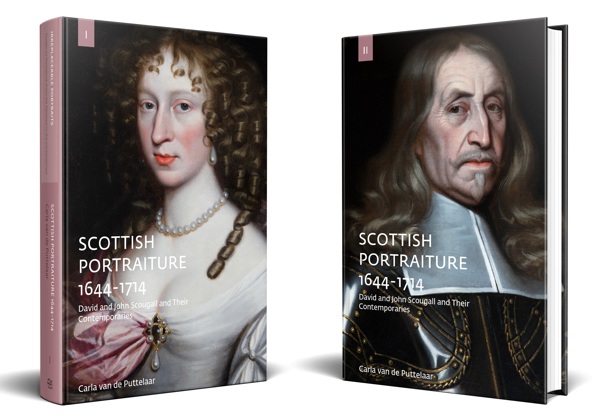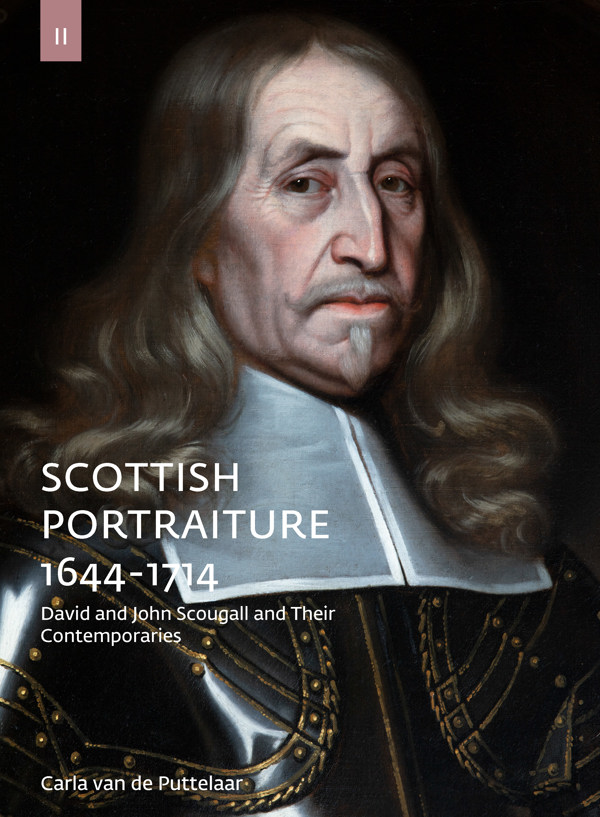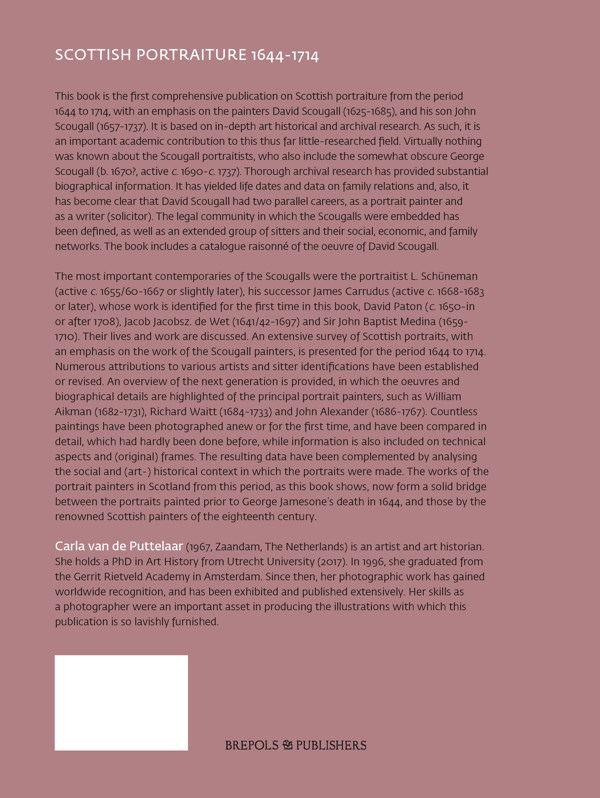
Scottish Portraiture 1644-1714
David and John Scougall and Their Contemporaries
Carla van de Puttelaar
- Pages:2 vols, 756 p.
- Size:225 x 300 mm
- Illustrations:1265 col.
- Language(s):English
- Publication Year:2021
- € 195,00 EXCL. VAT RETAIL PRICE
- ISBN: 978-2-503-59727-0
- Hardback
- Available
“Duncan Thompson’s foreword to this mighty work describes it as ‘an achievement for which everyone with an interest in British art in general should be grateful’ and that ‘the polity of Scotland owes [Carla van de Puttelaar] a great debt’. Indeed it does.” (Robin N. Campbell, in Scottish Society for Art History, 28, 2022, p. 95)
“Any student of Scotland’s history in the aftermath of a most troubled period in the mid-seventeenth century but before the rise of Jacobitism, the Act of Union in 1707 and the advent of the Enlightenment, will feel a debt of gratitude to Van de Puttelaar for revealing so clearly how the Scottish elites saw themselves in these remarkably unsparing portraits.” (Stephen Lloyd, in The Burlington Magazine, 165, August 2023, p. 923-924)
Carla van de Puttelaar (1967, Zaandam, The Netherlands) is an artist and art historian. She holds a PhD in Art History from Utrecht University (2017). In 1996, she graduated from the Gerrit Rietveld Academy in Amsterdam. Since then, her photographic work has gained worldwide recognition, and has been exhibited and published extensively. Her skills as a photographer were an important asset in producing the illustrations with which this publication is so lavishly furnished.
This book is the first comprehensive publication on Scottish portraiture from the period 1644 to 1714, with an emphasis on the painters David Scougall (1625-1685), and his son John Scougall (1657-1737). It is based on in-depth art historical and archival research. As such, it is an important academic contribution to this thus far little-researched field. Virtually nothing was known about the Scougall portraitists, who also include the somewhat obscure George Scougall (active c. 1690-1737). Thorough archival research has provided substantial biographical information. It has yielded life dates and data on family relations and, also, it has become clear that David Scougall had two parallel careers, as a portrait painter and as a writer (solicitor). The legal community in which the Scougalls were embedded has been defined, as well as an extended group of sitters and their social, economic, and family networks. The book includes a catalogue raisonné of the oeuvre of David Scougall.
The most important contemporaries of the Scougalls were the portraitist L. Schüneman (active c. 1655/60-1667 or slightly later), his successor James Carrudus (active c. 1668-1683 or later), whose work is identified for the first time in this book, David Paton (c. 1650-in or after 1708), Jacob Jacobsz. de Wet (1641/42-1697) and Sir John Baptist Medina (1659-1710). Their lives and work are discussed. An extensive survey of Scottish portraits, with an emphasis on the work of the Scougall painters, is presented for the period 1644 to 1714. Numerous attributions to various artists and sitter identifications have been established or revised. An overview of the next generation is provided, in which the oeuvres and biographical details are highlighted of the principal portrait painters, such as William Aikman (1682-1731), Richard Waitt (1684-1733) and John Alexander (1686-1767). Countless paintings have been photographed anew or for the first time, and have been compared in detail, which had hardly been done before, while information is also included on technical aspects and (original) frames. The resulting data have been complemented by analysing the social and (art-) historical context in which the portraits were made. The works of the portrait painters in Scotland from this period, as this book shows, now form a solid bridge between the portraits painted prior to George Jamesone’s death in 1644, and those by the renowned Scottish painters of the eighteenth century.
VOLUME I
Abbreviations – Foreword – Acknowledgements
Introduction
Current State of Published Research on the Scougalls and Their Circle and the Appreciation of Their Work Through the Centuries
The Elder Scougall/Old Scougall and the Younger Scougall
Dates and Scarcity of Known Archival Material
Artistic Context: Painting in Scotland, the Start of a Portrait Tradition, c. 1575-1660
David Scougall (Edinburgh, 1625-1685), His Life and Career
Emerging from the Shadows
Father and Son, John (d. after 13 October 1627) and David (1625-1685)
Writer and Painter
Family Patrons
The Outset of a Career
Father and Son, David (1625-1685) and John (1657-1737)
The Advocate’s Close
The Profession of a Writer or Clerk in the Time of David Scougall
The Profession of a Painter in the Time of David Scougall
Possible Teachers and Family Creativity
Decline and Death
Skougall or Scougall
Personal Network, Legal Community and Further Family Relations
John Scougall (Edinburgh, 1657-1737), His Life and Career
A Long and Prosperous Life
Becoming a Limner
Family Patrons
Increased Prosperity
Lack of Competition
1694: A Year of Important Changes
Decline in Skill and Death
David Scougall: The Oeuvre, Characteristics, Development and Sources of Inspiration
The Outset of a Career
Core Works, the Basis for a Compilation of the Oeuvre
Associated Works
Miniatures or Pocket Pictures
Stylistic Features and Motifs
Consistency in Style
Late Works, 1675-1685
Technical Aspects of David Scougall’s Paintings
Technical Research and Painting Technique
Painting Materials
David Scougall as a Copyist
Costumes and Jewellery
Use of Motifs from Portraits by Other Painters
No Inventor, but Painting Real People
Production
Studio Practice and Legal Community
John Scougall: The Oeuvre, Characteristics, Development and Sources of Inspiration
The Early Years
Indisputable Works
Associated Works
Use of Motifs from Portraits by Other Painters
Stylistic Features and Motifs
Technical Aspects of John Scougall’s Paintings
Technical Research and Painting Technique
John Scougall as a Copyist
Production
Mending and Washing
Studio Practice and Apprentices
George Scougall (b. 1670?, active c. 1690- c. 1737)
Lack of Biographical Data
In the Studio of John Scougall
Inadequate Traces of Work
Clients/Sitters
Nobility and Clergy
Clients and Religious Beliefs
Loyal Patrons
Bonding Portraits
Competition from Abroad
Ladies and Gentlemen
Portraying Children
Problems in Sitter Identification
Known Sitter, but Problem in Period and Handling
Portraits Telling the Truth?
Scougall’s Clients, Where Were They Based, and the Painter’s Studio
Backs and Frames
The Back of the Painting
Period Frames
Prices for Portraits and Frames
Prices for Portraits by David Scougall 1664-1683
Prices for Portraits by John Scougall 1674-1728
Prices for Frames
The Contemporaries of the Scougalls
John Michael Wright (1617-1694)
L. Schüneman (active c. 1655/60-1667 or shorty after)
James Carrudus (active 1671 or earlier-1683 or later)
David Paton (c. 1650-in or after 1708)
Thomas Murray (1663-1735)
Jacob Jacobsz. de Wet (1641/42-1697)
Portraits, Painters Unknown
Painters, Portraits Unknown
Sir John Baptist Medina (1659-1710)
The Next Generation
William Aikman (1682-1731)
Richard Waitt (1684-1733)
John Alexander (1686-1767)
John Smibert (1688-1751)
And Beyond
Summary and Conclusion
Appendices
Appendix I The Scougall Family, Reconstruction of the Family Tree
Appendix II Transcriptions of Various Archival Documents Concerning the Scougall Painters
Appendix III The Mysterious Portrait of ‘John Scougall’
Appendix IV Transcription of the Memoir by Sir John Clerk of Penicuik, 1st Baronet (1649-1722) of His Wife Elizabeth Henderson, Lady Clerk (1658-1683)
VOLUME II
Catalogue Raisonné of the Paintings by David Scougall (1625-1685)
Introduction
Glossary
Catalogue A Authentic Works
Catalogue AW Works Known Only from Written Sources
Catalogue B Copies by David Scougall After Works by Others
Catalogue C Doubtful Works
Catalogue D Works Known Only Through Copies and Prints
Catalogue E Rejected Works
Concordance
Notes
Bibliography
Websites
Guides to Houses and Other Venues
Exhibitions
Inserted Details
Index




